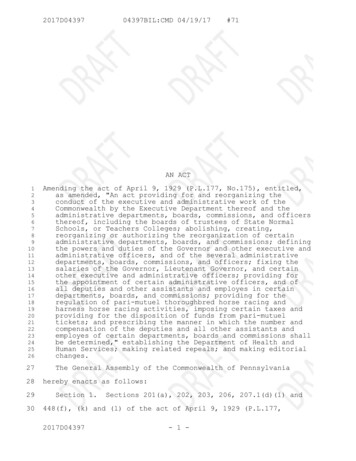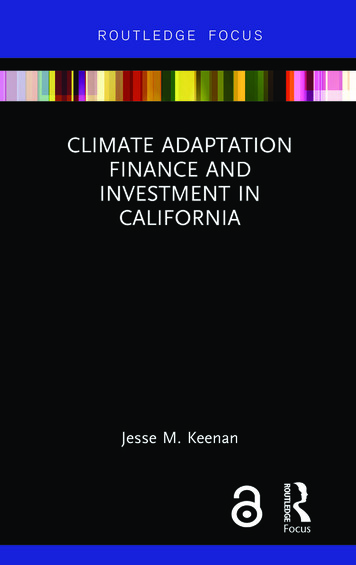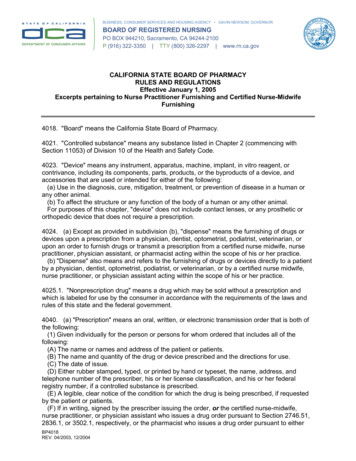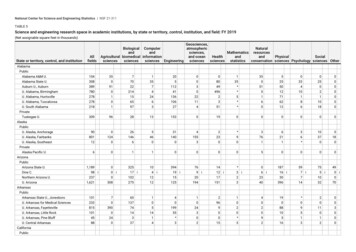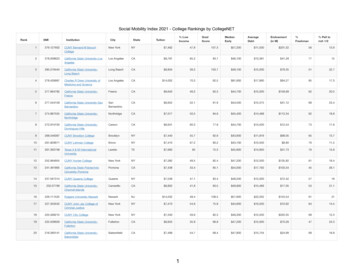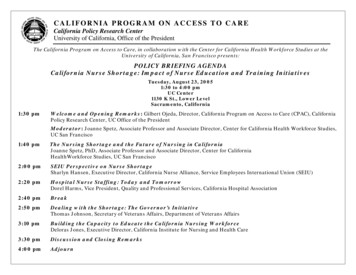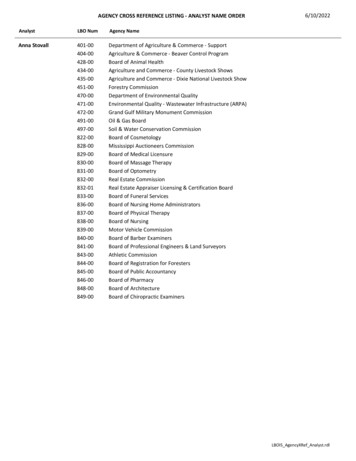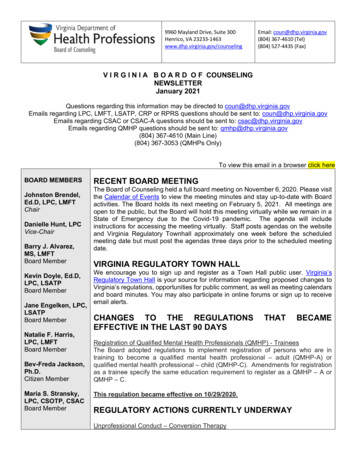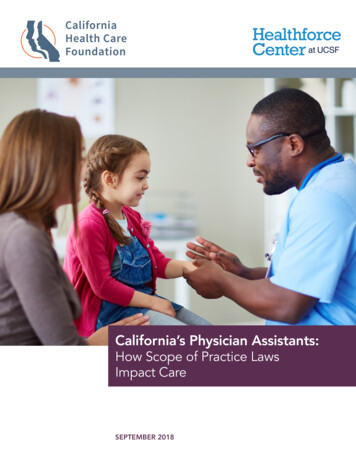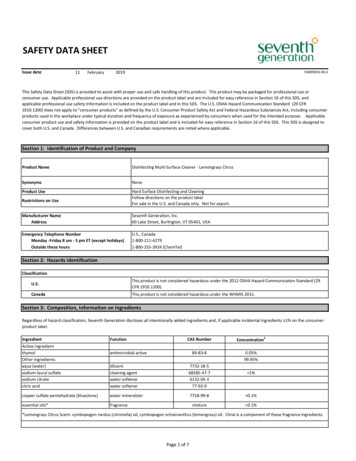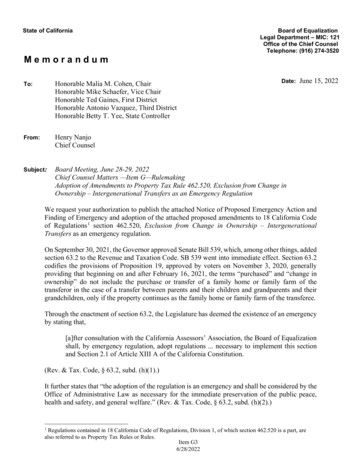
Transcription
State of CaliforniaMemorandumBoard of EqualizationLegal Department – MIC: 121Office of the Chief CounselTelephone: (916) 274-3520Date: June 15, 2022To:Honorable Malia M. Cohen, ChairHonorable Mike Schaefer, Vice ChairHonorable Ted Gaines, First DistrictHonorable Antonio Vazquez, Third DistrictHonorable Betty T. Yee, State ControllerFrom:Henry NanjoChief CounselSubject:Board Meeting, June 28-29, 2022Chief Counsel Matters —Item G—RulemakingAdoption of Amendments to Property Tax Rule 462.520, Exclusion from Change inOwnership – Intergenerational Transfers as an Emergency RegulationWe request your authorization to publish the attached Notice of Proposed Emergency Action andFinding of Emergency and adoption of the attached proposed amendments to 18 California Codeof Regulations 1 section 462.520, Exclusion from Change in Ownership – IntergenerationalTransfers as an emergency regulation.On September 30, 2021, the Governor approved Senate Bill 539, which, among other things, addedsection 63.2 to the Revenue and Taxation Code. SB 539 went into immediate effect. Section 63.2codifies the provisions of Proposition 19, approved by voters on November 3, 2020, generallyproviding that beginning on and after February 16, 2021, the terms “purchased” and “change inownership” do not include the purchase or transfer of a family home or family farm of thetransferor in the case of a transfer between parents and their children and grandparents and theirgrandchildren, only if the property continues as the family home or family farm of the transferee.Through the enactment of section 63.2, the Legislature has deemed the existence of an emergencyby stating that,[a]fter consultation with the California Assessors’ Association, the Board of Equalizationshall, by emergency regulation, adopt regulations . necessary to implement this sectionand Section 2.1 of Article XIII A of the California Constitution.(Rev. & Tax. Code, § 63.2, subd. (h)(1).)It further states that “the adoption of the regulation is an emergency and shall be considered by theOffice of Administrative Law as necessary for the immediate preservation of the public peace,health and safety, and general welfare.” (Rev. & Tax. Code, § 63.2, subd. (h)(2).)Regulations contained in 18 California Code of Regulations, Division 1, of which section 462.520 is a part, arealso referred to as Property Tax Rules or Rules.Item G36/28/20221
Honorable Board Members2June 15, 2022Property Tax Rule 462.520 was adopted by the Board through the regular rulemaking process onJuly 7, 2021 and became effective on January 1, 2022. Following the adoption of the rule,additional amendments were deemed necessary. This emergency action makes additionalamendments to Rule 462.520 to enable the administration of Article XIII A, section 2.1,subdivision (b) of the California Constitution and section 63.2 of the Revenue and Taxation Code,as follows: Improve clarity. These amendments reorganize subdivision (f) into two paragraphs,one dealing with the filing of the Homeowners’ or Disabled Veterans’ Exemption claimforms and one dealing with the filing of the Exclusion claim form. Since both forms arerequired to be filed, creating a paragraph for each form makes the Rule more readable andunderstandable. Further, Examples 9 and 10 were added to the end of subdivision (d).These examples demonstrate the operation and calculation of subdivisions (a)(1)(B) and(C), (a)(5), (b), (c), and (d) of the Rule. Definitions. Definitions of “foster child”, “third-party transfer”, and “legal parcel”were added at subdivision (e)(1)(E) and subdivision (e)(10) of the Rule respectively.“Foster child” was defined by section 63.2, subdivision (e)(1)(E) and its inclusion in theRule increases the usability of the Rule. “Third-party transfer” is defined as in prior Boardguidance (Assessors’ Handbook section 401, p. 99). Its inclusion increases the convenienceand usability of the Rule. The phrase “legal parcel” is used in section 63.2, subdivision(a)(2) to identify portions of property to which the exclusion may be applied is not defined.Because the Legislature’s intent was to allow the exclusion for portions of property thatcan be recognized as a separate parcel for legal purposes, it is necessary to create orreference an existing standard to determine when a parcel is recognized as separate. Insteadof creating a standard, reference is made to the Subdivision Maps Act which determineswhen a portion of property may be sold separate from other land of which it may be a part. Subdivision (e)(11)(A) clarifies that a principal residence does not cease to becomethe principal residence of a transferor on the death of the transferor. This is consistent withadministrative practice under Proposition 58 and 193, and with the administration of thehomeowners’ exemption. Accessory Dwelling Units. Subdivision (e)(11)(B) includes “accessory dwellingunit” (ADU) and “junior accessory dwelling unit” (JADU) as part of the principalresidence. This is consistent with recent legislation governing ADUs and JADUs andsimplifies administration of the exclusion. Subdivision (f)(1) and (5) clarifies that transferees are entitled to a refund of anyamounts paid erroneously if the homeowners’ exemption claim form is filed timely and toprospective relief if the homeowners’ exclusion claim form is filed late. Eligibility for theexclusion is dependent on the condition that the property is the principal residence of theeligible transferee. The filing of the homeowners’ exemption claim form merely evidencesthis fact. Whether the exclusion available or lost forever is not conditioned upon the filingof the form. Rather, a more reasonable interpretation of Section 2.1 is that although thehomeowners’ exemption claim form must be filed at the time of the purchase or transfer ofthe property, if the form is filed within one year the transferee is eligible for the exclusionand entitled to a refund of amounts previously owed or paid between the date of thepurchase or transfer and the date the transferee claims the homeowners’ exemption claimItem G36/28/2022(Rev. 1:6/22/2022)
Honorable Board Members3June 15, 2022form. If the homeowners’ exemption claim form is not filed within one year the transfereeis eligible for the exclusion, the transferee is not entitled to refunds, but may qualify for theexclusion prospectively. This is also consistent with prospective-only relief for late filingof the exclusion claim form.Emergency regulations approved by the Office of Administrative Law (OAL) are effective on thedate they are filed with OAL, and approved emergency regulations remain effective for 180 days.OAL may approve two re-adoptions of the same emergency regulation and each re-adoption mayextend the emergency regulation's effective period for up to 90 days. Emergency regulations arerepealed when their effective periods expire. However, an emergency regulation can becomepermanent if the Board re-adopts the regulation through the regular rulemaking process. Therefore,staff intends to begin the regular rulemaking process prior to the expiration of the emergencyregulation.Recommended by:Approved:/s/ Henry NanjoHenry D. Nanjo, Chief Counsel/s/ Yvette StowersYvette M. Stowers, Executive DirectorApproved:BOARD APPROVED on:/s/ David YeungDavid Yeung, Deputy DirectorProperty Tax DepartmentCatherine Taylor, ChiefBoard Proceedings DivisionAttachment: Notice of Proposed Emergency Actioncc: Ms. Yvette M. StowersMr. Henry NanjoMr. David YeungMs. Lisa ThompsonItem G36/28/2022
Notice of Proposed Emergency Action and Finding of EmergencyThe State Board of Equalization has Adopted California Code of Regulations, Title 18,Section 462.520, Exclusion from Change in Ownership – Intergenerational TransfersNOTICE IS HEREBY GIVEN that the State Board of Equalization (BOE), pursuant to theauthority vested by section 15606 of the Government Code and section 63.2 of the Revenue andTaxation Code, 1 has amended California Code of Regulations, title 18, section (Property TaxRule or Rule) 462.520, Exclusion from Change in Ownership – Intergenerational Transfers, asan emergency regulation in accordance with section 11346.1 of the Government Code, to becodified in division one of title 18 of the California Code of Regulations. Rule 462.520implements, interprets, and makes specific section 63.2 of the Revenue and Taxation Code whichwas enacted to set forth procedures and definitions implementing Article XIII A, section 2.1 ofthe California Constitution.FINDING OF EMERGENCYSection 48 StatementGovernment Code section 11346.1, subdivision (a)(2) requires that, at least five working daysprior to submission of the proposed emergency action to the Office of Administrative Law(OAL), the adopting agency provide a notice of the proposed emergency action to every personwho has filed a request for notice of regulatory action with the agency. After submission of theproposed emergency to OAL, the OAL shall allow interested persons five calendar days tosubmit comments on the proposed emergency regulations as set forth in Government Codesection 11349.6.Statement of EmergencyThe Legislature has deemed the existence of an emergency by enacting section 63.2 of theRevenue and Taxation Code, subdivision (h) of which states that,[a]fter consultation with the California Assessors’ Association, the board shall, byemergency regulation, adopt regulations . necessary to implement this sectionand Section 2.1 of Article XIII A of the California Constitution.It further states that “the adoption of the regulation is an emergency and shall be considered bythe Office of Administrative Law as necessary for the immediate preservation of the publicpeace, health and safety, and general welfare.”Property Tax Rule 462.520 was adopted by the Board through the regular rulemaking process onJuly 7, 2021 and became effective on January 1, 2022. Following the adoption of the rule,additional amendments were deemed necessary. This emergency action makes additionalamendments to Rule 462.520 to enable the administration of section 63.2 of the Revenue andTaxation Code and Article XIII A, section 2.1, subdivisions (c) and (d) of the CaliforniaConstitution.1All further statutory references are to the Revenue and Taxation Code unless otherwise indicated.Page 1 of 17Item G36/28/2022
AUTHORITYSection 15606, Government Code; section 63.2, Revenue and Taxation Code.REFERENCEArticle XIII A, sections 2 and 2.1, California Constitution; and sections 60 and 63.2, Revenueand Taxation Code.INFORMATIVE DIGEST/POLICY STATEMENT OVERVIEWCurrent LawProposition 13 was adopted by the voters at the June 1978 primary election and added articleXIII A to the California Constitution. Article XIII A generally limits the amount of ad valoremtax to a maximum of one percent of the full cash value of real property. For purposes of thislimitation, section 2 of article XIII A defines full cash value to mean a county assessor’svaluation of real property as shown on the 1975-76 tax bill, or thereafter, the appraised value ofthat real property when purchased, newly constructed, or a change in ownership has occurred. Ingeneral, properties are reassessed to current market value only upon a change in ownership or thecompletion of new construction, establishing a new “base year value” for property tax purposes.The California Legislature codified the definition of “change in ownership” in section 60 andcodified additional Revenue and Taxation Code sections regarding whether a transfer of propertyresults in a change in ownership, is excluded from the definition of “change in ownership”. (Rev& Tax. Code §§ 61 through 69.6).Relevant to this Rule, voters amended Article XIII A of the constitution to add two exclusionsfrom change in ownership. Specifically, Proposition 58, effective November 6, 1986, excludedfrom change in ownership certain transfers of real property between parents and children andProposition 193, effective March 27, 1996, excluded from change in ownership certain transfersof real property from grandparents to grandchildren, provided that all of the parents of thegrandchildren who qualify as children of the grandparents are deceased as of the date of transfer.These two constitutional amendments are reflected in section 2, subdivision (h) of article XIII Aof the California Constitution, codified at section 63.1 of the RTC, and are referred to as theParent-Child and Grandparent-Grandchild Exclusions, respectively.In the November 3, 2020 general election, the voters amended the constitution by approvingProposition 19 (Prop 19), which, amongst other things, created a new intergenerational transferexclusion (by adding Section 2.1, subdivisions (c) to article XIII A of the CaliforniaConstitution) and adopted a sunset date of February 15, 2021 (pursuant to Section 2.1,subdivision (d)) for the Parent-Child and Grandparent-Grandchild Exclusions.Beginning on and after February 16, 2021, section 2.1, subdivision (c) of article XIII A of theCalifornia Constitution provides that the terms “purchased” and “change in ownership” do notinclude the purchase or transfer of a family home or family farm of the transferor in the case of aPage 2 of 17Item G36/28/2022
transfer between parents and their children or grandparents and their grandchildren, only if theproperty continues as the family home or family farm of the transferee. This exclusion isavailable only up to a calculated amount. If the fair market value of the property is greater thanthat amount, partial relief is available. These provisions also apply to a purchase or transfer of afamily home or family farm between grandparents and their grandchildren, as long as all of theparents of those grandchildren, who qualify as children of the grandparents, are deceased as ofthe date of the purchase or transfer. No provision is made for the exclusion from change inownership of the transfer of any other type of property between parents and children orgrandparents and grandchildren.Effects, Objectives, and Benefits of the Amendments to the Property Tax RuleUnder the authority of Government Code section 15606, subdivision (c), which authorizes theBoard to prescribe rules and regulations to govern local boards of equalization and assessmentappeals boards when equalizing and county assessors when assessing, the Board adoptedProperty Tax Rule 462.520, Exclusion from Change in Ownership – Intergenerational Transfersto implement, interpret, and make specific the change in ownership provisions instituted byProposition 19 and section 63.2 through the regular rulemaking process.Following the adoption of Rule 462.520, additional amendments were deemed necessary tofurther implement, interpret, and make specific section 63.2. Pursuant to section 63.2, which wasenacted subsequent to the adoption of Rule 462.520 through the regular rulemaking process,these amendments to the Rule to implement section 63.2 and section 2.1 of Article XIII A of theCalifornia Constitution are made through the emergency rulemaking process.The amendments to Rule 462.520 make the following changes: Improve clarity. These amendments reorganize subdivision (f) into twoparagraphs, one dealing with the filing of the Homeowners’ or Disabled Veterans’Exemption claim forms and one dealing with the filing of the Exclusion claimform. Since both forms are required to be filed, creating a paragraph for each formmakes the Rule more readable and understandable. Further, Examples 9 and 10were added to the end of subdivision (d). These examples demonstrate theoperation and calculation of subdivisions (a)(1)(B) and (C), (a)(5), (b), (c), and (d)of the Rule. Definitions. Definitions of “foster child”, “third-party transfer”, and “legal parcel”were added at subdivision (e)(1)(E) and subdivision (e)(10) of the Rulerespectively. “Foster child” was defined by section 63.2, subdivision (e)(1)(E) andits inclusion in the Rule increases the usability of the Rule. “Third-party transfer”is defined as in prior Board guidance (Assessors’ Handbook section 401, p. 99).Its inclusion increases the convenience and usability of the Rule. The phrase“legal parcel” is used in section 63.2, subdivision (a)(2) to identify portions ofproperty to which the exclusion may be applied is not defined. Because theLegislature’s intent was to allow the exclusion for portions of property that can berecognized as a separate parcel for legal purposes, it is necessary to create orPage 3 of 17Item G36/28/2022(Rev. 1: 6/22/2022)
reference an existing standard to determine when a parcel is recognized asseparate. Instead of creating a standard, reference is made to the SubdivisionMaps Act which determines when a portion of property may be sold separatefrom other land of which it may be a part. Subdivision (e)(11)(A) clarifies that a principal residence does not cease tobecome the principal residence of a transferor on the death of the transferor. Thisis consistent with administrative practice under Proposition 58 and 193, and withthe administration of the homeowners’ exemption. Accessory Dwelling Units. Subdivision (e)(11)(B) includes “accessory dwellingunit” (ADU) and “junior accessory dwelling unit” (JADU) as part of the principalresidence. This is consistent with recent legislation governing ADUs and JADUsand simplifies administration of the exclusion. Subdivision (f)(1) and (5) clarifies that transferees are entitled to a refund of anyamounts paid erroneously if the homeowners’ exemption claim form is filedtimely and to prospective relief if the homeowners’ exclusion claim form is filedlate. Eligibility for the exclusion is dependent on the condition that the property isthe principal residence of the eligible transferee. The filing of the homeowners’exemption claim form merely evidences this fact. Whether the exclusion availableor lost forever is not conditioned upon the filing of the form. Rather, a morereasonable interpretation of Section 2.1 is that although the homeowners’exemption claim form must be filed at the time of the purchase or transfer of theproperty, if the form is filed within one year the transferee is eligible for theexclusion and entitled to a refund of amounts previously owed or paid betweenthe date of the purchase or transfer and the date the transferee claims thehomeowners’ exemption claim form. If the homeowners’ exemption claim form isnot filed within one year the transferee is eligible for the exclusion, the transfereeis not entitled to refunds, but may qualify for the exclusion prospectively. This isalso consistent with prospective-only relief for late filing of the exclusion claimform.The above clarifications are reasonably necessary for the efficient and fair administration of thechange in ownership provisions under section 63.2 and section 2.1 of article XIII A of theCalifornia Constitution applicable to base year value transfers. The Board anticipates that theamendments to the Proposed Rule will increase openness and transparency in government andbenefit the public, local boards of equalization and assessment appeals boards, county assessors,and owners of property potentially eligible for a base year value transfer provided by section63.2.The Board has performed an evaluation of whether the amendments to proposed Property TaxRule 462.520 are inconsistent or incompatible with existing state regulations. The Board hasdetermined that the amendments to the Proposed Rule are not inconsistent or incompatible withexisting state regulations because there are no other Property Tax Rules that prescribe thePage 4 of 17Item G36/28/2022
provisions that would be adopted by the amendments to the Rule. In addition, there is nocomparable federal regulation or statute to Property Tax Rule 462.520.DOCUMENTS RELIED UPON LTA No. 2022/014 (Dated April 1, 2022)LTA No. 2021/054 (Dated December 3, 2021)Chief Counsel Memorandum to Board Members Dated April 16, 2021,Incorporated into the April 27, 2021 Minutes by Referenceo Notice of Proposed Regulatory Actiono Initial Statement of Reasons for Proposed Ruleo Rule TextAssembly Constitution Amendment Number 11 (ACA 11)Legislative Analyses for ACA 11o Assembly Committee on Budgeto Assembly Third Readingo Senate Committee on Appropriationso Senate Committee on Budget and Fiscal Reviewo Senate Committee on Elections and Constitutional Amendmentso Senate Rules CommitteeProposition 19 Ballot Pamphleto Analysis of MeasureChief Counsel Memorandum to Board Members dated January 8, 2021o Proposition 19 – Initial Interpretational Questions and AnswersLTA No. 2020/061 (Dated December 11, 2020)LTA No. 2021/008 (Dated February 16, 2021)LTA No. 2021/010 (Dated March 5, 2021)Related Correspondence Submitted for and Comments Made During the Board’sDiscussion of the Issues and In Deciding to Propose the New Ruleo December 17, 2020 Board Meetingo January 14-15, 2021 Board Meetingo February 11, 2021 Board MeetingMANDATE ON LOCAL AGENCIES AND SCHOOL DISTRICTSSection 7 of SB 791 states that if the “Commission on State Mandates determines that this actcontains costs mandated by the state, reimbursement to local agencies and school districts forthose costs shall be made pursuant to Part 7 (commencing with Section 17500) of Division 4 ofTitle 2 of the Government Code.” Since SB 791 and its amendments, enactments, and repealsdesignate a lead county assessor and allocate new responsibilities, county assessor offices maybe impacted and thus, the emergency regulation imposes a mandate on a local agency that isreimbursable.Page 5 of 17Item G36/28/2022
EFFECTIVE PERIODGovernment Code section 11346.1, subdivision (e) provides that emergency regulations mayremain in effect for 180 days from adoption. Therefore, the amendments to Rule 462.520 shall beeffective immediately upon filing with the Secretary of State and shall remain in effect for 180days from that date, unless the BOE amends, renews, or repeals it before the expiration of the180-day period.CONTACT PERSONSQuestions regarding the substance of Rule 462.520 should be directed to Honey Her, RegulationsCoordinator, by telephone at (916) 274-3523, by e-mail at Honey.Her@boe.ca.gov, or by mail atCalifornia State Board of Equalization Legal Department, Attn: Honey Her, MIC:121, P.O. Box942879, Sacramento, CA 94279-0121.Page 6 of 17Item G36/28/2022
[TEXT OF PROPOSED AMENDMENTS IN UNDERLINE AND STRIKEOUT]RULE 462.520. EXCLUSION FROM CHANGE IN OWNERSHIP – ction 15606, Government Code.Article XIII A, Section 2.1, California Constitution; and Sections 60 and 63.2, Revenue and Taxation Code.(a) GENERAL. Beginning on and after February 16, 2021, "change in ownership" shall not include thetransfer of real property which is the principal residence or the family farm of an eligible transferor in thecase of transfers between parents and their children or between grandparents and their grandchildren,meeting the following conditions:(1) The principal residence or family farm of the transferor must become the principal residence or thefamily farm of at least one eligible transferee within one year of the transfer.(A) If the transfer is of a principal residence, an eligible transferee must file a claim for thehomeowners' or disabled veterans' exemption at the time of the transfer or within one year of the transfer.(B) If the transfer is of a family farm, an eligible transferee need not file a claim for either thehomeowners' or disabled veterans' exemption. A family farm is not required to include a principalresidence to qualify for this exclusion.(C) A claim for exclusion under this section may be filed separately for a principal residence on afamily farm if that principal residence meets all the requirements of this section.(2) The real property must continue to be the principal residence or the family farm of an eligibletransferee. As of the date the property is no longer the principal residence or the family farm of an eligibletransferee, the exclusion shall be removed and the taxable value of the property shall be determinedpursuant to subdivision (d) of this rule. However, if another eligible transferee qualifies for the exclusionwithin one year of the property no longer qualifying as the principal residence of the previous eligibletransferee, the exclusion shall not be removed.(3) In the case of transfers between grandparents and grandchildren, all of the parents of thosegrandchildren, who qualify as children of the grandparents, are deceased as of the date of the transfer,except that a son-in-law or daughter-in-law of the grandparent who is a stepparent to the grandchild neednot be deceased on the date of the transfer.(4) A claim for the exclusion sought pursuant to this section is filed with the county assessor inaccordance with subdivision (f)(2) of this rule. An assessor may request any other information reasonablyrelated to the claim they deem necessary to verify the exclusion.(5) Nothing in this section limits the number of principal residences or family farms of a transferor thatmay be transferred to an eligible transferee and excluded from change in ownership.(b) VALUATION.(1) Upon transfer, the principal residence or family farm obtains a new base year value equal to its fullcash value on the date of transfer multiplied by the percent ownership of the principal residence or familyfarm transferred plus the factored base year value of the percent ownership of the principal residence orfamily farm not transferred.(2) If a transferee meets the requirements for exclusion under this section, the principal residence orfamily farm will be assessed at its New Taxable Value in accordance with subdivision (c) of this rule ratherthan its new base year value.Page 7 of 17Item G36/28/2022
(3) When the real property is no longer the principal residence or the family farm of an eligibletransfereeas required by subdivision (a)(2) of this rule, the new taxable value upon removal of the exclusion shall bedetermined pursuant to subdivision (d) of this rule.Example 1: Base Year Value Calculation. Parent transfers 100 percent interest in their principalresidence to Child. On March 1, 2021, the date of transfer, the principal residence has a factored baseyear value of 250,000 and a full cash value of 900,000. The principal residence's new base year valueis 900,000. If Child meets the requirements for exclusion under this section, the principal residence willbe assessed at its New Taxable Value, in accordance with subdivision (c) of this rule, rather than its newbase year value.Example 2: Base Year Value Calculation. Parent transfers 75 percent interest in their principalresidence to Child and retains 25 percent interest. On March 1, 2021, the date of transfer, the principalresidence has a factored base year value of 250,000 and a full cash value of 900,000. The principalresidence's new base year value is 675,000 ( 900,000 full cash value multiplied by the 75 percentinterest transferred to Child) plus 62,500 ( 250,000 factored base year value multiplied by the 25 percentinterest retained by Parent) equals 737,500. If Child meets the requirements for exclusion under thissection, the principal residence will be assessed at its New Taxable Value, in accordance with subdivision(c) of this rule, rather than its new base year value.(c) NEW TAXABLE VALUE. The New Taxable Value of the principal residence or family farm shall bethe sum of the amounts calculated in paragraphs (1) through (3):(1) Eligible Transferee's New Taxable Value: the sum of the factored base year value of the principalresidence or family farm immediately prior to the date of transfer plus any Excess Amount. This amountshall be multiplied by the percent interest of the principal residence or family farm transferred to eligibletransferees.(A) "Excess Amount" means the full cash value of the principal residence or family farm on thedate of transfer minus the Excluded Amount. If this amount is less than or equal to zero, the ExcessAmount is zero.(B) "Excluded Amount" means the factored base year value of the principal residence or familyfarm immediately prior to the date of transfer plus 1,000,000, adjusted pursuant to subdivision (g) of thisrule.(2) Noneligible Transferee's New Taxable Value: the full cash value of the principal residence orfamily farm on the date of transfer multiplied by the percent interest transferred to noneligible transferees.(3) Factored Base Year Value of Non-Transferred Interest: the factored base year value of the principalresidence or family farm immediately prior to the date of transfer multiplied by the percent interest nottransferred.(4) The New Taxable Value shall be adjusted by an inflation factor, as provided in subdivision (a) ofsection 51 of the Revenue and Taxation Code.Example 3: Excess Amount Calculation. On March 1, 2021, Parents' principal residence has afactored base year value of 250,000. The Excluded Amount is 1,250,000 ( 1,000,000 plus 250,000factored base year value). Parents transfer 100 percent interest in their principal residence to Child onMarch 1, 2021.Examples 3-1 and 3-2 demonstrate alternatives using the facts described in Example 3.Example 3-1: Zero Excess Amount. The principal residence has a full cash value of 900,000 onthe date of transfer. Since 900,000 is less than the 1,250,000 Excluded Amount, the Excess Amount iszero. Therefore, the New Taxable Value on the date of transfer is the factored base year value of 250,000.Page 8 of 17Item G36/28/2022
Example 3-2: Excess Amount. The principal residence has a full cash value of 1,300,000 on thedate of transfer. Since 1,300,000 is greater than the 1,250,000 Excluded Amount, there is an ExcessAmount of 50,000. Therefore, the New Taxable Value of the principal residence on the date of transfer is 300,000 ( 250,000 factored base year value plus 50,000 Excess Amount).Example 4: Transfer to both Eligible and Non-Eligible Transfer
Office of the Chief Counsel Telephone: (916) 274-3520 . M e m o r a n d u m . To: Honorable Malia M. Cohen, Chair . Date: June 15, 2022 Honorable Mike Schaefer, Vice Chair . Honorable Ted Gaines, First District . Honorable Antonio Vazquez, Third District . Honorable Betty T. Yee, State Controller . From: Henry Nanjo . Chief Counsel . Subject:

